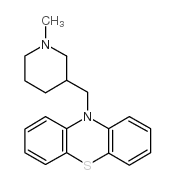CHEMICAL IDENTIFICATION
-
RTECS NUMBER :
-
SP2625000
-
CHEMICAL NAME :
-
Phenothiazine, 10-((1-methyl-3-piperidyl)methyl)-
-
CAS REGISTRY NUMBER :
-
60-89-9
-
LAST UPDATED :
-
199707
-
DATA ITEMS CITED :
-
6
-
MOLECULAR FORMULA :
-
C19-H22-N2-S
-
MOLECULAR WEIGHT :
-
310.49
-
WISWESSER LINE NOTATION :
-
T C666 BN ISJ B1- CT6NTJ A1
HEALTH HAZARD DATA
ACUTE TOXICITY DATA
-
TYPE OF TEST :
-
LD50 - Lethal dose, 50 percent kill
-
ROUTE OF EXPOSURE :
-
Intraperitoneal
-
SPECIES OBSERVED :
-
Rodent - rat
-
DOSE/DURATION :
-
200 mg/kg
-
TOXIC EFFECTS :
-
Details of toxic effects not reported other than lethal dose value
-
REFERENCE :
-
FATOAO Farmakologiya i Toksikologiya (Moscow). For English translation, see PHTXA6 and RPTOAN. (V/O Mezhdunarodnaya Kniga, 113095 Moscow, USSR) V.2- 1939- Volume(issue)/page/year: 24,136,1961
-
TYPE OF TEST :
-
LD50 - Lethal dose, 50 percent kill
-
ROUTE OF EXPOSURE :
-
Intraperitoneal
-
SPECIES OBSERVED :
-
Rodent - mouse
-
DOSE/DURATION :
-
140 mg/kg
-
TOXIC EFFECTS :
-
Behavioral - somnolence (general depressed activity)
-
REFERENCE :
-
ARZNAD Arzneimittel-Forschung. Drug Research. (Editio Cantor Verlag, Postfach 1255, W-7960 Aulendorf, Fed. Rep. Ger.) V.1- 1951- Volume(issue)/page/year: 8,489,1958
-
TYPE OF TEST :
-
LD50 - Lethal dose, 50 percent kill
-
ROUTE OF EXPOSURE :
-
Subcutaneous
-
SPECIES OBSERVED :
-
Rodent - mouse
-
DOSE/DURATION :
-
750 mg/kg
-
TOXIC EFFECTS :
-
Details of toxic effects not reported other than lethal dose value
-
REFERENCE :
-
CANJAE Canadian Anaesthetists' Society Journal. (Toronto, Ont., Canada) V.1-33, 1954-86. Volume(issue)/page/year: 3,224,1956
-
TYPE OF TEST :
-
LD50 - Lethal dose, 50 percent kill
-
ROUTE OF EXPOSURE :
-
Intravenous
-
SPECIES OBSERVED :
-
Rodent - mouse
-
DOSE/DURATION :
-
70 mg/kg
-
TOXIC EFFECTS :
-
Details of toxic effects not reported other than lethal dose value
-
REFERENCE :
-
ARZNAD Arzneimittel-Forschung. Drug Research. (Editio Cantor Verlag, Postfach 1255, W-7960 Aulendorf, Fed. Rep. Ger.) V.1- 1951- Volume(issue)/page/year: 4,232,1954
-
TYPE OF TEST :
-
LD50 - Lethal dose, 50 percent kill
-
ROUTE OF EXPOSURE :
-
Intravenous
-
SPECIES OBSERVED :
-
Rodent - rabbit
-
DOSE/DURATION :
-
20 mg/kg
-
TOXIC EFFECTS :
-
Details of toxic effects not reported other than lethal dose value
-
REFERENCE :
-
CANJAE Canadian Anaesthetists' Society Journal. (Toronto, Ont., Canada) V.1-33, 1954-86. Volume(issue)/page/year: 3,224,1956 *** REVIEWS *** TOXICOLOGY REVIEW JMSCA9 Journal of Mental Science. (London, UK) V.4-108, 1857-1962. For publisher information, see BJPYAJ. Volume(issue)/page/year: 106,755,1960
|
